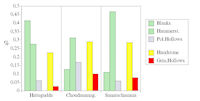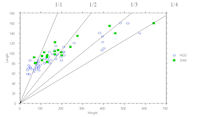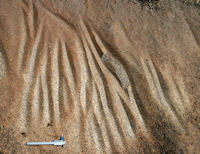
Figure 7: Circular structure (Feature 1) in Hiregudda – Area A (Photograph by P. Whittaker)
The excavation and survey campaigns carried out between 1997 and 2006 on all three settled inselbergs around the dolerite quarry have provided information about the social and economic organisation of axe production in the Sanganakallu area. Though the archaeological record of the area is still undergoing study, these findings offer some insights into the social relations of production in the second millennium BCE. One of the central issues concerns the social access to critical natural resources and the organisation of the different production stages among the population, as well as the possible emergence of relations of social and political dependency.
The lithic material recovered along the dolerite outcrop corresponds to the quarrying activity itself, as well as to a massive amount of flaking of bifacial axe blanks. Large amounts of reduction flakes and discarded axe blanks cover the south-eastern slope of Hiregudda. As one moves up the dyke, other stone artefacts, such as handstones, or mano, and grinding slabs for cereal processing, as well as pottery, begin to appear. This shows that the dolerite outcrop lay close to settlement areas expanding on the hill of Hiregudda, and seems to have overlapped with them. Hence, quarrying activity was not taking place in a separated and exclusive territory, as was the case at Great Langdale or other European extraction sites (Bradley and Edmonds 1993; Petrequin and Jeunesse 1995; Le Roux 2002; Petrequin et al. 2006), but rather formed part of a more or less loosely settled territory. It still needs to be clarified if the occupation next to the quarry was a permanent form of settlement, or rather some form of temporary, seasonal arrangement. In any case, the central and south-eastern part of the Hiregudda plateau, 80-120m away from the dyke, shows evidence of a rather stable form of occupation.
Intensive survey and excavations have been carried out at the upper end of the dolerite dyke, in Area A of Hiregudda. In addition to containing a partly destroyed ashmound, this site presents the most outstanding accumulations of dolerite debitage waste of any of the Sanganakallu settlements. Of particular interest is a round structure, 7m in diameter and visible on the surface, named Feature 1, which was fully excavated (Fig. 7). The use of this structure dates between 1700 and 1250 cal BCE, with a possible hiatus between 1500-1400 BCE (Fuller et al. 2007). While stone artefact production debris is found throughout the structure's sequence, the lithic-rich upper deposits inside and around this building, containing hundreds of thousands of flakes from axe manufacturing, accumulated to a large extent between c. 1500/1400 and 1250 cal BCE. The volume and type of flakes strongly supports the idea that this stone-lined circular structure functioned as a specialised lithic production 'workshop' for the manufacture of axes and other dolerite implements, such as chisels. The long, narrow and more or less cylindrical preform of these latter artefacts requires a particularly skilful knapping technique, which seems to have been exclusive to Area A and particularly to Feature 1.
While the manufacture of dolerite axes was the dominant activity over at least the last 150 years Feature 1 was occupied, it is equally clear that other activities also took place within this building. Apart from dozens of dolerite, gabbro, quartz and hematite hammerstones and a large stone slab with polishing grooves linked to axe production, the structure's users disposed of cereal processing tools (handstones and querns), polishing artefacts and even one pottery burnisher. Finished axes and chisels suggest that wood-working could have been carried out as well. Repairing and resharpening of edge tools also took place, as can be inferred from the presence of flake and non-flake debitage bearing ground facets as well as some reworked axes (Brumm et al. 2007).
The spatial distribution of the artefacts and debris within Feature 1 shows a clear pattern, and the structure appears to have been entered from the south. According to the distribution of debitage waste, axe production seems to have been 3.3 times more intense in the western than in the eastern half of the room. A large immobile granite quern placed in the south-east corner seems to have been transformed during the final occupation into an axe-grinding artefact, which may indicate the greater importance of axe production activities during the last centuries of the occupation. Pottery and ashes are more frequent in the north-eastern corner, suggesting that this was an area for food preparation and consumption. Outside the dwelling, large amounts of knapping debris accumulated and seem to have resulted from periodic cleaning of its inner space. The presence of 16 grinding grooves on granite boulders recorded in Hiregudda, absent or rare on the other hill settlements, confirms that the specialised edge grinding and finishing of axes and chisels represented another important and time-consuming activity in Area A. Clearly, the inhabitants of other more 'domestic' structures and dwellings identified in the vicinity were participating in these tasks and maintained a close relation with the production processes taking place in Feature 1. The analysis of the knapping debitage as well as of the discarded axe blanks has confirmed that a variety of working methods were carried out inside and outside Feature 1 by persons showing very different levels of technical competence. This pattern does not conform to a highly specialised workshop, nor to domestic production with a specialised working tradition passed from generation to generation. While a typical example of the first is the modern production of beads in Khambat, Western India (Kenoyer et al. 1991), the domestic type of specialisation would include the blade production proposed for the Magdalenian of the Paris basin (Pigeot 1987); for a general discussion on the meaning of technical specialisation, see Risch 2008). Rather, the combination of technically diverse, and at the same time more and more intense knapping during the last 150-250 years of the occupation of the site, suggests collective production carried out by a team of part-time knappers and polishers, whose target was mass production rather than the development of a high degree of technical expertise. The lack of concern with raw material maximisation indicates that good dolerite stone was abundant and easily accessible.
Access to the dolerite stone was not exclusive to the inhabitants of Hiregudda. The lithic records of Choudammagudda and Sannarachammagudda show that these settlements obtained natural slabs or blocks as well as half-finished blanks from the same dyke (Fig. 8). Percussion tools as well as dolerite debitage confirm that their populations were producing or finishing axe blanks. Differences in the organisation of axe production between communities emerge in the intensity of finds rather than in the organisation of activities. Thus, while discarded axe blanks represent around 30% of the macro-lithic tools recorded at Hiregudda Area A, their importance drops to around 10-15% at the other sites (Fig. 8).
The results obtained from the other settlements do not show a superior or inferior degree of technical competence among their knappers. Discarded blanks from Choudammagudda and Sannarachamma show the same type of working procedures and mistakes in comparison to the areas close to the quarry, although axe production was clearly a less important activity. Handstones, a clear indicator of the processing of cereal and other crops, represent more than 30% of the macro-lithic tools recorded through systematic surface survey in these two settlements. In Hiregudda they only represent around 24% of the macro-lithic assemblage. The frequency of surface grinding slabs and hollows is much larger at Choudammagudda and Sannarachamma than at Hiregudda, also suggesting differences in the activities conducted in the settlements (Fig. 8).

Figure 8: Relative proportion (100%=1) of the main stone artefact categories in the three settlements of the Sanganakallu-Kupgal archaeological complex (axe blanks, hammerstones, polishing hollows are mainly related to axe production; handstones and grinding hollows are the main food-processing tools). These results are based on systematic surface recording of artefacts. Comparison with the material from test trenches shows a high correspondence between values.
The hill settlement of Choudammagudda, located 700m south-west of the dolerite quarry, is characterised by a significantly high number of surface axe-grinding hollows. Given its size, it may have been occupied by the largest community of the Sankanakallu area (although the limited excavations so far suggest that deposits may not be as deep as at the other sites) and it is possible that it could therefore have devoted more work-force time to axe polishing. The large number of handstones, grinding slabs and grinding hollows recorded on the surface suggests the permanent character of this settlement and the importance of the processing and consumption of agricultural products within it.
The southernmost settlement of the Sanganakallu-Kupgal complex, at Sannarachammagudda, has a surprisingly high proportion of percussion stones, particularly of dolerite and gabbro, confirmed both through surface survey and excavation (Trench 10). The presence of dolerite blocks, flakes and blanks on the site confirms that this community obtained useful raw materials from the Hiregudda quarry and participated in axe production. According to the length/weight index of axe blanks used to describe technical competence, the knapping skills at Sannarachamma were not lower than those displayed at Hiregudda (Fig. 9). Other aspects of the knapping process show that all three sites shared the same technology and expertise. However, the high proportion of hammerstones at the southern hill site can also be related to the knapping of other materials, including the production of small flake and bladelet tools on quartz and chert, as well as to the preparation and maintenance of cereal-grinding tools, which have here a similar importance to that observed at Choudammagudda (Fig. 8). Finally, the low number of grinding hollows and grooves at Sannarachamma indicate that a limited work-force was involved in axe grinding at this site.

Figure 9: Differences between Hiregudda (Area A) and Sannarachammagudda (Trench 10) in relation to the length and weight ratio of axe blanks. Lines mark the relation between length and weight and are therefore indicative of higher (left) or lower (right) technical competence.
In general, it can be concluded that the same set of stone tools and raw materials were produced, maintained and used on all three hills. All settlements had direct access to the dolerite quarry or, at least, to the products produced there, as the presence of unworked blocks and blanks suggest. Economic differences existed among the settlements as demonstrated by different work efforts and the different activities performed at the settlements. While Hiregudda, and particularly Area A, centred on the quarrying and working of dolerite, the other settlements appear to have been more agriculturally oriented. The transactions between the settlements seem to have been fluid, given the exchange of materials and technologies between them. One might even ask if Area A, at least during the final occupation phase, was more of a working area used periodically by groups coming from the other settlements, rather than a settlement itself. In any case, the presence of a considerable quantity of crop-grinding hollows, as well as the evidence from Feature 1 itself, suggests that everyday subsistence activities were not an unusual activity in the area.
The distribution and organisation of the means of production in the Sanganakallu area indicates a considerable circulation in terms of populations, raw materials, axe blanks, technological skills and, typically, subsistence goods between the three hill settlements. The division of tasks within this society seems to have been limited, and in general all communities living in this area were engaged to a certain extent in the flaking, pecking and grinding of dolerite axes. However, the production of chisels appears to have been restricted to one area close to the dolerite outcrop. So far, the study of the lithic means of production does not suggest any marked division of labour between settlements nor in the excavated house units. Neither can signs of economic centralisation be identified in the area. Yet, the scale of axe production leaves no doubt that we are not dealing in any of the three hill-settlements with a self-sufficient communal production. No approximate calculation of the total volume of axes produced in the Sanganakallu area has been carried out so far, but the figure definitely lies in the many thousands, rather than the hundreds. The manufacture of such quantities of utilitarian objects only makes sense if an extra-regional distribution system existed.

Figure 10: Partial view of the area with polishing grooves located in the plain below Sanarachammagudda and next to the modern village of Sanganakallu (Photograph by J.A. Soldevilla)
In this socio-economic context, it is of interest that the most highly specialised activity area discovered so far lies separated from all settlement areas, c. 400m south-east of Sannarachamma. On several more or less flat granite bedrock surfaces across an area of c. 30x25m, we have recorded up to 138 grinding grooves (for previous discussion of these grinding grooves, see Subbarao 1948; Brumm et al. 2007, 73.). Probably their original number was much higher, given erosion processes and destruction caused due to their position next to the modern village of Sanganakallu. All grooves show the characteristic 'V' section already observed around Feature 1 of Hiregudda, although many are much larger, reaching up to 1m in length (Fig. 10). In fact, they are the result of a successive juxtaposition of several shorter grooves. Such grooves do not seem appropriate for the grinding or polishing of the axes, nor their cutting edges, which require wider, flat or 'U' shaped grooves, as known from African, Australian as well as European axe production areas (e.g. Shaw 1944; McCarthy 1976, 54). Rather, these grinding surfaces seem to result from polishing the lateral margins and the butt of the axes and, in consequence, they must be related to the finishing of axes or chisels.
Although the labour force responsible for the development of such grooves is considerable, as became manifest in the experimental tests, no settlement traces can be identified in the neighbourhood. Even if the modern village may have disturbed such deposits, surface finds should be expected. The clear spatial separation of this area must result from an intentional social or political decision, as no significant geological differences exist between this bedrock and the granite forming the surfaces of all three inselbergs. In fact, similar lateral grinding was carried out on a much more limited scale on Hiregudda Area A and occasionally also on Sannarachamagudda. Consequently, these specific axe-grinding activities and/or the persons carrying them out were maintained apart from the everyday habitation areas. Our impression is that other groups were present in this specialised area. Its position on the plain, south of the two largest habitation sites and away from and out of sight of the dolerite quarry would be an appropriate location at which to engage with communities of a wider region and carry out the exchange of either axe blanks or more or less finished products. Perhaps the finishing of the axe margins in such a context of negotiation might have been considered a proof of the value of the offered products. Alternatively, axe finishing may have been carried out by the visiting groups themselves, or by diverse communities during the course of social and exchange activities.
© Internet Archaeology/Author(s) URL: http://intarch.ac.uk/journal/issue26/26/4.html
Last updated: Wed Jul 29 2009